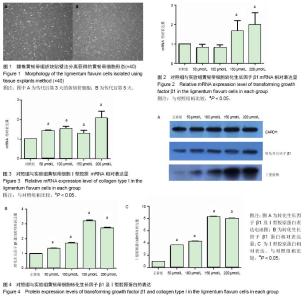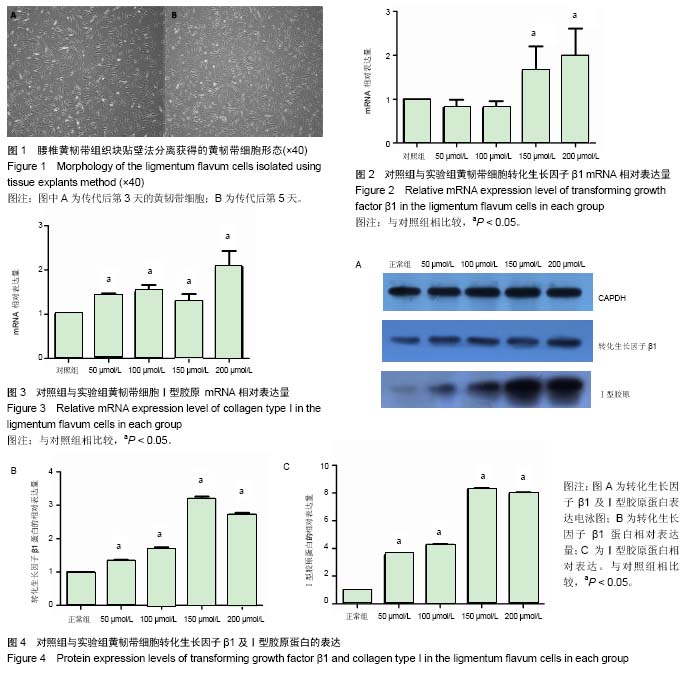| [1] Okuda T, Baba I, Fujimoto Y, et al.The pathology of ligamentum flavum in degenerative lumbar disease.Spine (Phila Pa 1976).2004;29(15):1689-1697.[2] Rispoli R, Mastrostefano R, Brunelli F. Morphology and TGF-beta1 concentration analysis of ligamentum flavum in patients with lumbar canal stenosis and lumbar disc herniation.Neuroradiol J.2010;23(3):347-353.[3] Park JB,Chang H,Lee JK.Quantitative analysis of transforming growth factor-beta 1 in ligamentum flavum of lumbar spinal stenosis and disc herniation.Spine (Phila Pa 1976).2001;26(21):E492-495.[4] Park JB, Lee JK, Park SJ,et al. Hypertrophy of ligamentum flavum in lumbar spinal stenosis associated with increased proteinase inhibitor concentration.J Bone Joint Surg Am. 2005;87(12):2750-2757.[5] Nakatani T,Marui T,Hitora T,et al.Mechanical stretching force promotes collagen synthesis by cultured cells from human ligamentum flavum via transforming growth factor-beta1.J Orthop Res.2002;20(6):1380-1386.[6] Finkel T,Holbrook NJ.Oxidants, oxidative stress and the biology of ageing. Nature.2000; 408(6809):239-247.[7] Choe Y,Yu JY,Son YO,et al.Continuously generated H2O2 stimulates the proliferation and osteoblastic differentiation of human periodontal ligament fibroblasts.Cell Biochem. 2012; 113(4):1426-1436.[8] Akhtar K, Broekelmann TJ, Miao M, et al. Oxidative and nitrosative modifications of tropoelastin prevent elastic fiber assembly in vitro.J Biol Chem.2010; 285(48):37396-404.[9] Fukuyama S,Nakamura T,Ikeda T,et al.The effect of mechanical stress on hypertrophy of the lumbar ligamentum flavum.J Spinal Disord.1995;8:126-130.[10] Nakatani T, Marui T, Hitora T, et al.Mechanical stretching force promotes collagen synthesis by cultured cells from humanligamentum flavum via transforming growth factor-β1.J Orthop Res.2002;20: 1380-1386.[11] Kong MH, Morishita Y,He W,et al.Lumbar segmental mobility according to the grade of the disc, the facet joint, the muscle, and the ligament pathology by using kinetic magnetic resonance imaging. Spine.2009;34: 2537–2554.[12] Nakamura T, Okada T, Endo M, et al. Angiopoietin-like protein 2 induced by mechanical stress accelerates degeneration and hypertrophy of the ligamentum flavum in lumbar spinal canal stenosis.PLoS One.2014;9(1):e85542.[13] Park JO, Lee BH, Kang YM, et al. Inflammatory cytokines induce fibrosis and ossification of human ligamentum flavum cells.J Spinal Disord Tech.2013;26:E6-E12.[14] Kang YM, Suk KS, Lee BH, et al.Herniated intervertebral disk induces hypertrophy and ossification of ligamentum flavum.J Spinal Disord Tech.2014;27(7):382-389.[15] Viejo-Fuertes D,Liguoro D,Rivel J,et al.Morphologic and histologic study of the ligamentum flavum in the thoraco-lumbar region.Surg Radiol Anat. 1998;20(3):171-176.[16] 张宇,吴少鹏,夏雄智,等.人黄韧带细胞体外原代培养方法的比较[J].广东医学,2011,(13):1668-1671.[17] Schmid P, Itin P, Cherry G, et al.Enhanced expression of transforming growth factor-β type I and type II receptors in wound granulation tissue and hypertrophic scar.Am J Pathol. 1998;152:485-493.[18] Ganas K,Loukides S,Papatheodorou G.et al.Total nitrite/nitrate in expired breath condensate of patients with asthma. Respir Med.2001;95(8):649-654 |

